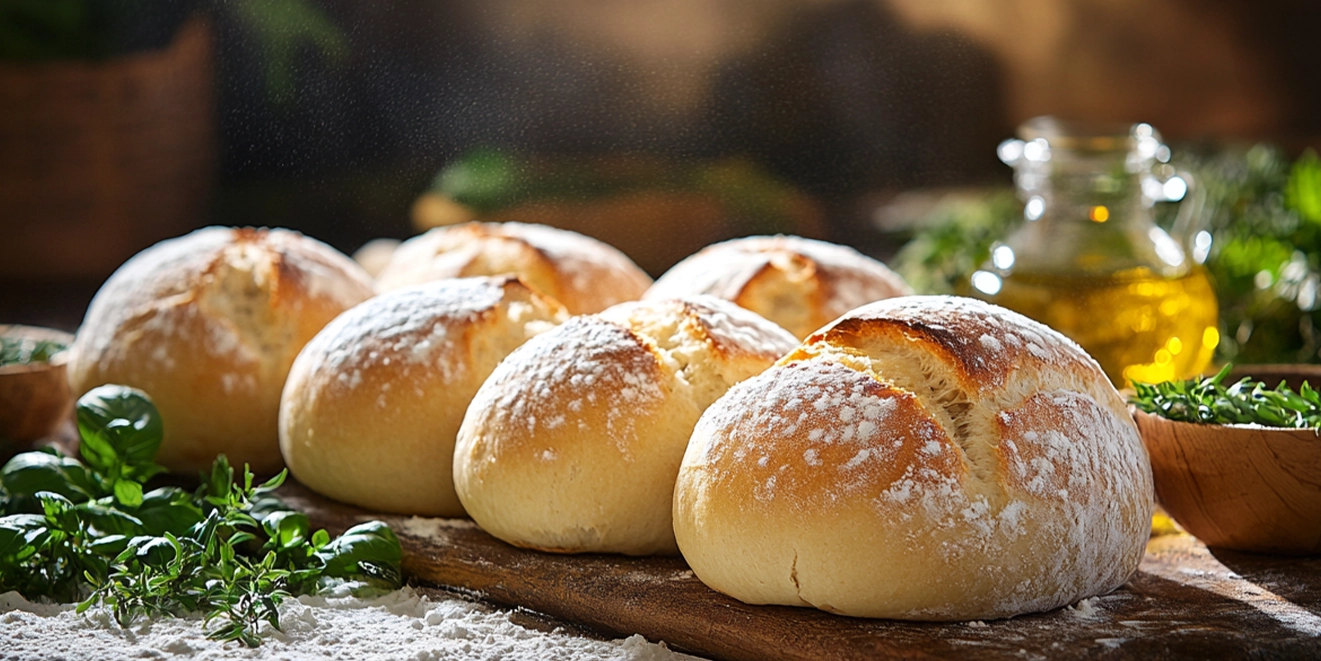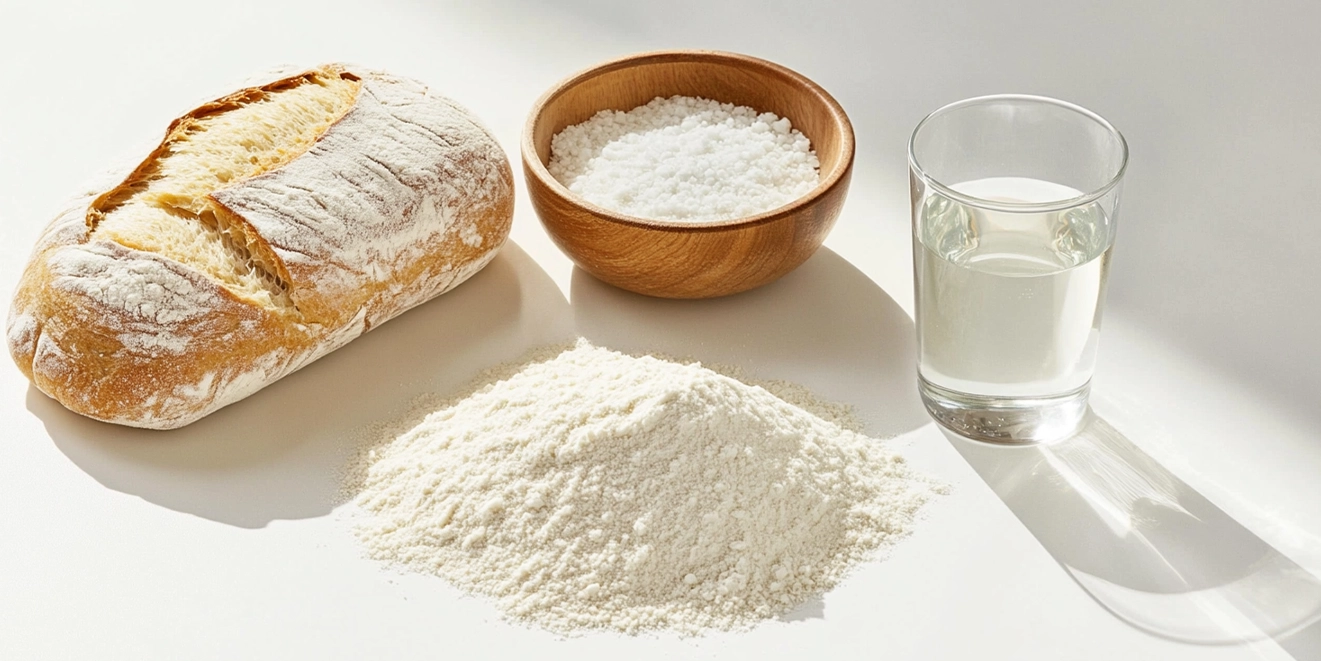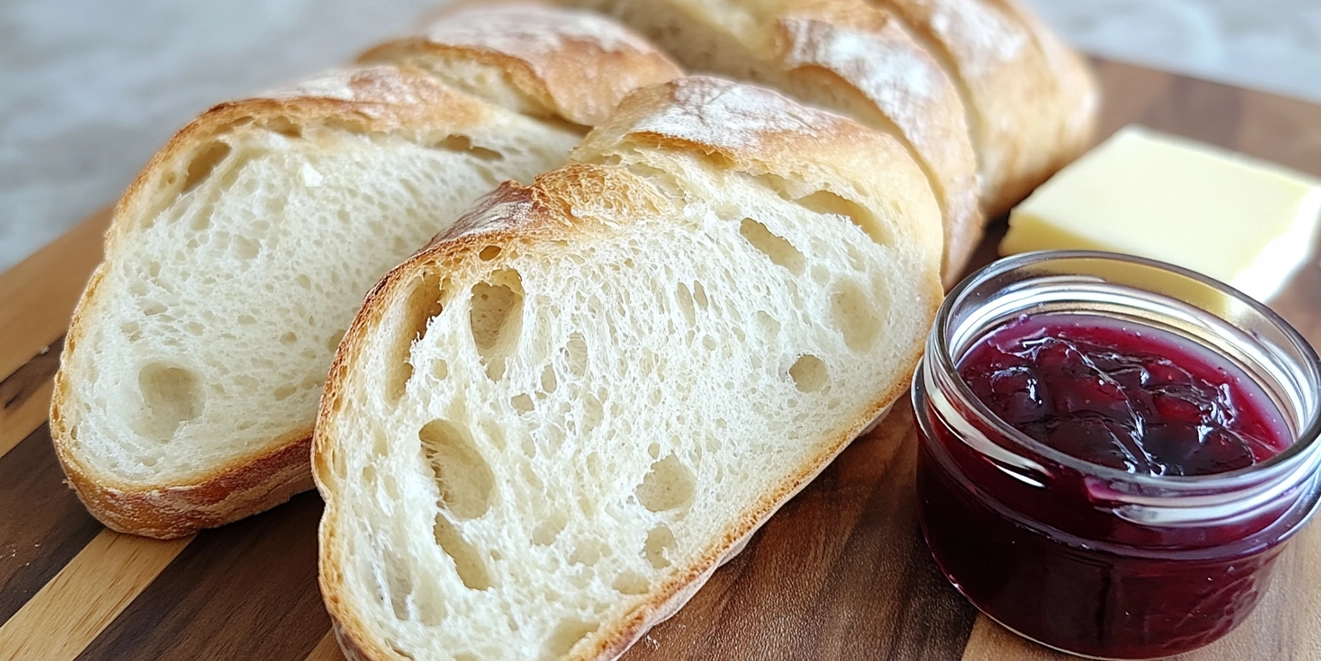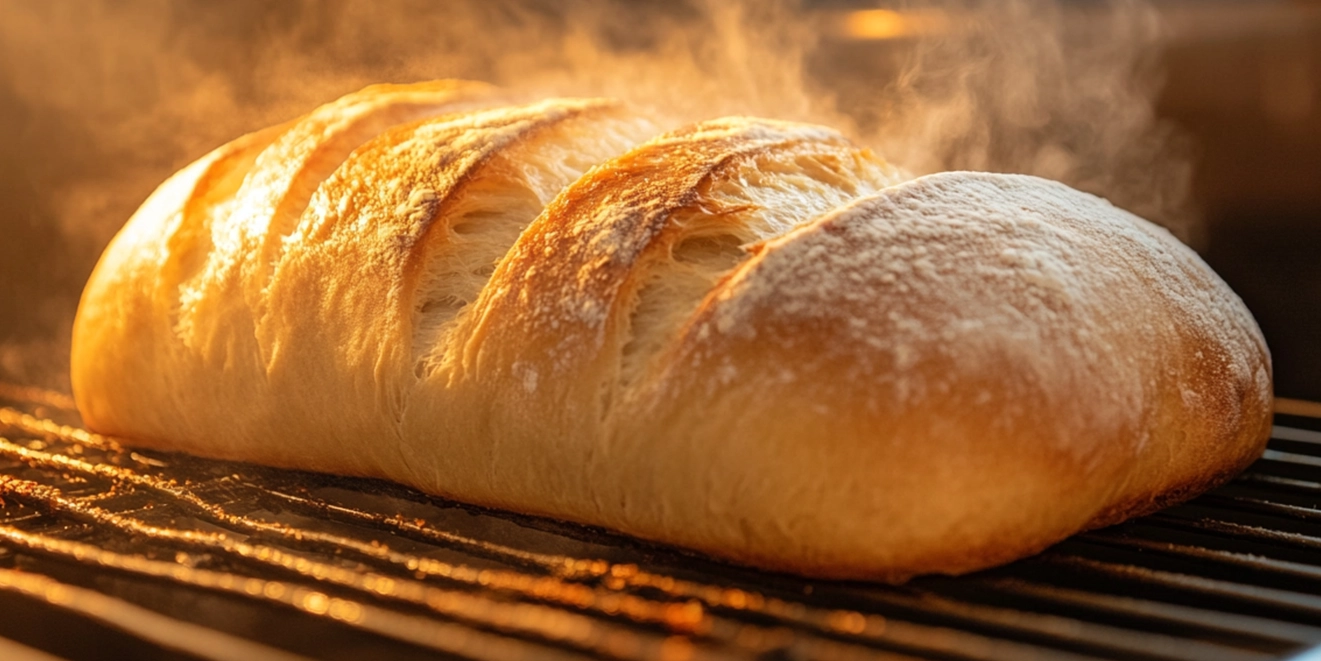The Ultimate Guide to French Bread: History, Recipes, and Baking Tips

Introduction to French Bread
French bread, renowned for its crisp crust, airy interior, and delightful flavor, has become a global symbol of French culinary tradition. Originating from France, this bread includes a variety of iconic loaves, with the baguette being the most famous. French bread is special in daily life, often accompanying meals or enjoyed with butter or jam.
Its popularity stems not only from its versatility but also from the artistry involved in its creation. French bakers adhere to centuries-old techniques, using simple ingredients—flour, water, salt, and yeast—to craft bread with perfect texture and taste. Today, French bread is celebrated worldwide, reflecting its cultural significance and timeless appeal.
Historical Origins of French Bread
French bread has a rich history that dates back to ancient times, evolving alongside the culinary traditions of France. The early forms of bread in France were simple flatbreads made by early civilizations. By the Middle Ages, bread became a staple in French households, with bakers developing techniques to improve flavor and texture.
During the 17th and 18th centuries, French bakers refined their craft, and bread began to take on more distinct forms. Bread laws were introduced to standardize baking practices, ensuring fair access to quality loaves for all social classes. This period laid the foundation for France’s deep cultural connection to bread.
Evolution of the Baguette
The iconic baguette, often synonymous with French bread, emerged much later, during the 19th and 20th centuries. While its origins are debated, the baguette’s development is usually linked to advancements in baking technology, such as the introduction of steam ovens, which helped create its signature crispy crust.
In 1920, a law restricting bakers’ working hours encouraged the production of faster-to-make bread. The baguette quickly gained popularity for its convenience, affordability, and delicious taste. Its long, slender shape also made it easy to bake and transport.
Key Ingredients in French Bread
The beauty of French bread lies in its simplicity. It relies on just a few essential ingredients to create its iconic taste and texture, and each ingredient plays a critical role in achieving the perfect loaf.
Flour Types Used in French Bread
The type of flour is a cornerstone of French bread making. French bakers traditionally use Type 55 flour, a low-protein wheat flour that provides the ideal balance of strength and lightness for a crisp crust and soft, airy interior. This flour has a lower gluten content than other bread flour, allowing the dough to maintain its elasticity without becoming too dense.
In addition to Type 55 flour, whole wheat or rye flour is sometimes used for specialty breads like pain complet or pain de seigle. Each flour type adds unique flavors and textures while preserving the artisanal quality of French bread.
Importance of Yeast
Yeast is essential for leavening, helping the dough rise and develop its signature airy crumb. French bread traditionally uses natural or fresh baker’s yeast, promoting slow fermentation. This slow rise allows for complex flavors and a rich aroma, distinguishing French bread from quicker alternatives.
In some cases, bakers also use levain (natural sourdough starter), which adds a slight tanginess and enhances the bread’s depth of flavor while acting as a natural preservative.
The Role of Water and Salt
Water is crucial in hydrating the flour, activating the yeast, and creating the dough’s structure. Its mineral content and purity can influence the bread’s final texture, making it an often-overlooked ingredient that skilled bakers value.
Salt is equally vital, as it enhances the flavor, controls yeast activity, and strengthens the gluten network in the dough. Without salt, bread would taste bland, and the fermentation process might become uncontrollable—properly measured salt balances all the elements, ensuring the perfect crust, flavor, and texture.

How to Perfect Your French Bread
Here are a few tips to achieve the perfect loaf:
- Use Quality Ingredients: Simple ingredients mean quality matters.
- Steam is Key: Steam in the oven helps create a crisp crust.
- Knead Properly: Proper kneading develops gluten for the perfect chewiness.
If you want to learn more about handling bread dough, check out How to Make a Baguette Soft. It explains tips for keeping your French bread fresh and fluffy.
Traditional French Bread Recipes
Classic Baguette Recipe
The baguette is a quintessential French bread known for its crispy crust and light, airy interior.
Ingredients:
- 500g Type 55 flour (or bread flour)
- 10g salt
- 5g fresh yeast (or 2g instant dry yeast)
- 350ml lukewarm water
Instructions:
- Dissolve the yeast in lukewarm water and let it sit for 5 minutes.
- In a large bowl, mix flour and salt, then gradually add the yeast-water mixture. Stir until a dough forms.
- Knead the dough for 8-10 minutes until smooth and elastic.
- Cover and let it rise for 1-2 hours or until doubled in size.
- Divide the dough into three equal pieces, shape them into baguettes, and place them on a floured baking tray.
- Let the baguettes proof for another 30-45 minutes.
- Preheat the oven to 240°C (475°F). Score the baguettes with a sharp blade and bake for 20-25 minutes, using steam (place a tray of water at the bottom of the oven).
- Remove when golden brown and crispy. Cool before slicing.
French Boule Recipe
The boule (“ball”) is a round, rustic loaf perfect for sandwiches or soups.
Ingredients:
- 500g bread flour or Type 55 flour
- 10g salt
- 5g instant yeast
- 300ml lukewarm water
Instructions:
- Combine flour, salt, and yeast in a bowl. Gradually add the water while mixing.
- Knead the dough for 10 minutes until smooth and elastic.
- Cover and let the dough rise for 1.5-2 hours until doubled in size.
- Punch down the dough, shape it into a round ball, and place it on a floured baking sheet.
- Let it be proof for another 45 minutes. Score the top of the boule with an “X” using a sharp blade.
- Preheat the oven to 230°C (450°F). Bake for 25-30 minutes with steam for a crispy crust.
- Remove, let it cool, and enjoy its hearty flavor.
Variations of French Bread

Baguette, Brioche, Pain de Campagne
- Baguette: Made with flour, water, salt, and yeast, the baguette relies on technique to achieve its crisp crust and airy crumb.
- Brioche: A rich, buttery bread with a soft, tender crumb, brioche incorporates eggs, sugar, and butter, making it slightly sweet and ideal for breakfast or desserts.
- Pain de Campagne: Known as “country bread,“ this rustic loaf often uses a mix of white flour, whole wheat flour, and sometimes rye flour. Due to natural fermentation, it features a chewier texture and slightly sour flavor.
Differences in Ingredients and Methods
- Ingredients: Brioche includes butter, eggs, and sugar, unlike the simple composition of baguettes. Pain de Campagne often uses sourdough starter instead of yeast.
- Methods: Baguettes require quick shaping and short proofing, while brioche and pain de campagne involve longer fermentation for more decadent flavors.
Importance of Flour in French Bread
Understanding Protein Content in Flour
The protein content in flour determines the gluten formation, directly affecting the bread’s texture. French bread requires a moderate protein level (around 11-12%) in Type 55 flour. This allows for a light crumb and crisp crust without becoming overly dense.
Why All-Purpose Flour Isn’t Ideal
All-purpose flour often needs more consistency and structure than traditional French bread. Its lower protein content can result in loaves with a softer, less desirable texture and reduced chewiness. For authentic results, bread flour or Type 55 flour is recommended.
Role of Yeast in French Bread
Fermentation Process Explained
Yeast is responsible for the fermentation process. It feeds on sugars in the flour, producing carbon dioxide and alcohol. This process creates air pockets in the dough, leading to the light, airy texture characteristic of French bread. Slow fermentation allows for deeper, more complex flavors to develop.
How Yeast Affects Taste and Texture
- Taste: Natural fermentation produces subtle, tangy notes, while commercial yeast yields a cleaner flavor.
- Texture: Yeast creates gas bubbles that expand during baking, giving bread its open crumb. Proper yeast activity ensures even fermentation and avoids dense or uneven bread.
How Water Quality Impacts French Bread
Ideal Water Hardness and Its Importance
Water hardness refers to the mineral content in water, primarily calcium and magnesium. Moderately complex water (containing balanced minerals) strengthens gluten formation, which improves the dough’s elasticity and structure. Soft water, on the other hand, can result in weaker gluten and poorer texture.
Avoiding Chlorinated Water
Chlorinated water can inhibit yeast activity, negatively affecting fermentation and the bread’s final flavor. Bakers often use filtered or spring water to ensure optimal yeast performance and a clean, natural taste in their bread.
Salt’s Role in Enhancing French Bread
Balancing Flavor and Structure
Salt is a critical ingredient in French bread, contributing to its flavor and structural integrity.
- Flavor Enhancement: Salt enhances the natural flavors of the flour and yeast, preventing the bread from tasting bland. It brings out subtle nuances in the dough, creating the perfect balance of flavors. Without salt, French bread would lack depth and complexity.
- Control of Fermentation: Salt regulates yeast activity during fermentation by slowing down the process. This controlled fermentation allows flavors to develop gradually, resulting in a more decadent, aromatic bread.
- Strengthening Gluten Structure: Salt strengthens the dough’s gluten network, improving elasticity and stability. A strong gluten structure lets the dough trap carbon dioxide effectively, leading to a light, airy crumb and a well-formed loaf.
- Crust Formation: Salt contributes to the formation of a crispy crust by aiding moisture control during baking. It helps create the golden-brown color and satisfying crunch characteristic of French bread.
Step-by-Step Process of Making French Bread

Mixing, Kneading, Fermentation
- Mixing:
- Combine the key ingredients: flour, water, yeast, and salt. Start by dissolving yeast in lukewarm water and mixing it with the flour. Gradually add the salt to ensure it doesn’t initially come in direct contact with the yeast, which could inhibit its activity.
- Stir until a shaggy dough forms, ensuring all the ingredients are evenly incorporated.
- Kneading:
- Knead the dough for 8–10 minutes until it becomes smooth and elastic. This process develops the gluten, giving the dough structure and stretchiness. Proper kneading ensures the dough can trap gas during fermentation, creating a light crumb.
- Test the dough with the windowpane test: stretch a small piece of dough gently—if it forms a thin, translucent sheet without tearing, it’s ready.
- Fermentation:
- Place the kneaded dough in a lightly oiled or floured bowl. Cover it with a damp cloth or plastic wrap. Allow the dough to rise for 1–2 hours or until it has doubled.
- Fermentation allows yeast to produce carbon dioxide, which aerates the dough and develops flavor as natural sugars are consumed.
Shaping, Proofing, and Baking
- Shaping:
- Once the dough has risen, gently punch it to release excess gas. Divide it into equal portions, depending on the size and type of bread you’re making (e.g., baguettes or boules).
- For baguettes: Roll each portion into a rectangle, then fold and roll it tightly into a long, slender shape.
- For boules: Shape the dough into a round ball, tucking the edges underneath to create surface tension.
- Proofing:
- Place the shaped dough on a floured baking sheet or proofing basket. Cover and let it rest for 30–45 minutes. This final proofing (second rise) allows the dough to relax and expand, ensuring an airy interior.
- Before baking, score the dough with a sharp blade (lame or razor) to create cuts on the surface. This helps control how the bread expands in the oven and gives it a traditional look.
- Baking:
- Preheat the oven to 230–240°C (450–475°F). To achieve a crispy crust, use steam— place a tray of water in the bottom of the oven or spray water on the oven walls as you start baking.
- Bake for 20–25 minutes for baguettes or 30–35 minutes for larger loaves. The bread is done when it is golden brown, and the crust sounds hollow when tapped.
- Let the bread cool on a wire rack to allow the crust to set correctly.
Traditional Baking Methods
Wood-Fired Ovens vs. Modern Ovens
- Wood-Fired Ovens: Traditional French bread, particularly in rural areas, was baked in wood-fired ovens, which provide intense, even heat and a unique flavor. The radiant heat and natural steam created during baking result in a crispy, golden crust and a soft, chewy crumb. Wood-fired ovens also allow the bread to bake at very high temperatures, which is essential for the classic French bread texture.
- Modern Ovens: Modern convection or electric ovens have become the standard for home and professional baking. While they lack the distinct smoky aroma of wood-fired ovens, they offer precise temperature control and consistent results. Bakers often mimic the wood-fired effect by introducing steam and baking at high heat.
How Steam Enhances Crust Formation
Steam plays a crucial role in creating the signature crispy crust of French bread:
- Steam keeps the dough’s surface moist at the start of baking, delaying crust formation and allowing the bread to expand fully.
- As baking progresses, the moisture evaporates, creating a crisp, caramelized crust through the Maillard reaction.
- Steam also contributes to the bread’s golden-brown color, making it look professional and artisanal.
Nutritional Value of French Bread
Macronutrient Breakdown
A standard serving of French bread (1 slice, ~50g) typically contains:
- Calories: ~140–150 kcal
- Carbohydrates: ~28–30g (mostly complex carbs)
- Protein: ~4–5g
- Fat: ~0–1g (virtually no fat in traditional recipes)
- Fiber: ~1–2g (higher in whole grain variations)
Health Benefits and Considerations
- Benefits:
- French bread is low in fat and free from added sugars, making it a healthier option than processed bread.
- It provides a good source of energy from complex carbohydrates.
- Variants like pain complet (whole grain bread) offer higher fiber content, aiding digestion.
- Considerations:
- French bread is relatively high in carbohydrates, so portion control is essential for individuals managing blood sugar levels.
- It lacks significant vitamins and minerals unless made with enriched flour or whole grains.
French Bread in French Culture
Symbolism of Bread in French Society
Bread holds deep cultural significance in France, symbolizing unity, tradition, and community. Historically, bread was a staple food for all social classes, and access to bread was a central point of contention during events like the French Revolution. The phrase “bread is life“ captures its vital role in French society.
Daily Consumption and Traditions
- Daily Ritual: Fresh bread, particularly the baguette, is purchased daily from local bakeries (boulangeries). It’s often enjoyed at breakfast, with meals, or as a snack.
- Traditional Customs: Sharing bread at the table signifies togetherness. Breaking bread is a cherished act of hospitality in French households.
- Baking Competitions: Events like the annual “Best Baguette in Paris“ highlight the pride and skill of French bakers.
Bread is not merely food in France—it’s a cultural icon woven into daily life.
Common Mistakes When Making French Bread
Using the Wrong Ingredients
- Substituting all-purpose flour for Type 55 or bread flour can lead to improper gluten development, resulting in a dense crumb instead of the desired light, airy texture.
- Overusing yeast or skipping salt can disrupt flavor balance and fermentation.
Over-Kneading and Improper Proofing
- Over-Kneading: While kneading develops gluten, over-kneading can make the dough too tight, limiting its ability to rise properly and creating a tough texture.
- Improper Proofing:
- Under-proofing: The dough won’t rise fully, leading to a dense and heavy loaf.
- Over-proofing: The dough collapses during baking, losing its structure and resulting in flat, deflated bread.
- Always allow sufficient fermentation time and monitor the dough closely for optimal proofing to achieve the best results.
Delicious Pairings for French Bread
French bread complements numerous dishes. The possibilities are endless, whether served as a starter, a snack, or part of a main course.
- Enjoy it with The Ultimate Guide to Making Baked Beans, a savory combination perfect for a hearty meal.
- Pair it with Chicken Casserole Recipes for a complete family-friendly dinner.
- For a delicious twist, use slices to soak sauces from the Shrimp Boil Recipe or Smoked Brisket Recipe.
Frequently Asked Questions (FAQs)
1. How is French bread different from regular bread?
French bread is distinct from regular bread due to its simple ingredients and unique baking methods. Traditional French bread contains only flour, water, yeast, and salt, without added fats or sugars. It is baked at high temperatures, often with steam, which gives it a crisp crust and an airy, chewy crumb. Regular bread, such as sandwich loaves, may include fats, sugars, and preservatives, resulting in a softer texture and longer shelf life.
2. Is French bread healthy to eat?
Yes, French bread can be considered healthy when consumed in moderation. It is:
- Low in fat and free of added sugars.
- A good source of complex carbohydrates for energy.
- However, it is lower in fiber and nutrients compared to whole-grain breads. People with specific dietary needs, like managing blood sugar, should consume it in controlled portions.
3. Is French Toast made of French bread?
Yes, French toast is often made using French bread, such as baguettes or brioche. The bread’s sturdy texture makes it ideal for soaking up the egg and milk mixture without becoming too soggy. While any bread can be used for French toast, day-old French bread is preferred because it absorbs the mixture well and develops a crispy exterior when cooked.
4. Does French bread contain eggs?
Traditional French bread, such as the baguette, does not contain eggs. Authentic French bread uses only flour, water, yeast, and salt. However, enriched French breads like brioche contain eggs, butter, and sugar, giving them a rich, tender texture and slightly sweet flavor.
Conclusion
French bread, with its rich history, simple ingredients, and meticulous baking methods, is a timeless symbol of French culinary tradition. From the iconic baguette to rustic boules and buttery brioche, French bread showcases the artistry and dedication of bakers who transform basic components—flour, water, yeast, and salt—into something extraordinary.
Its crisp crust, airy interior, and unmistakable aroma have made it a beloved staple worldwide. Its cultural significance in France highlights the deep connection between food, community, and heritage. Whether enjoyed fresh with a meal, as the base for French toast, or as a standalone snack, French bread remains a simple yet sophisticated delight.
